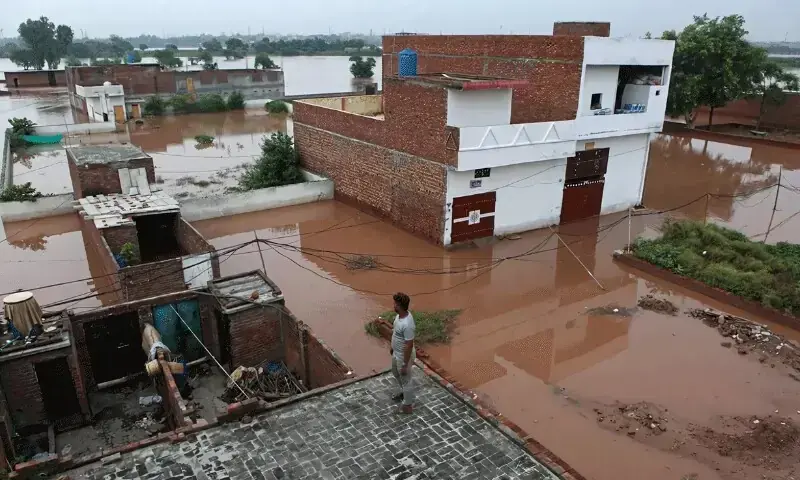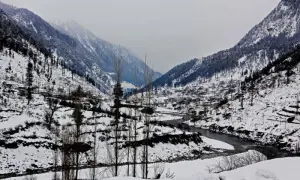Situation at Sidhnai headworks critical, hundreds of villages facing flood risk
The flood situation in Punjab remained critical on Thursday as all major rivers – Ravi, Chenab and Sutlej – swelled further after India released more water into Chenab.
In Multan, floodwaters from the Chenab River have reached the railway bridge, resulting in the submergence of several settlements in Shujabad and Pindi Bhattian.
In Sharqpur, crops and orchards have been destroyed, while hundreds of livestock have perished in the rising waters.
The Provincial Disaster Management Authority (PDMA) Punjab has declared the situation at the Sidhnai headworks on the Ravi River as alarming, raising concerns that all villages in Mandi Bahauddin could be inundated if water levels continue to rise.
Earlier, India contacted Pakistan at the diplomatic level for the second time within 24 hours, alerting authorities to a high flood situation in the Sutlej River.
In response, authorities in Pakistan issued an official advisory to all concerned institutions and departments.
The authorities have warned of a possible rise in water levels in the Sutlej River, particularly at Harike and Ferozepur, where a flood risk remained high.
A formal notification has also been issued to 28 departments and agencies, asking them to remain on high alert and take necessary measures to handle any situation arising from the expected flooding.
Water level at Shahdara rising again
Meanwhile, Director General of the Provincial Disaster Management Authority (PDMA) Irfan Ali Kathia, on Thursday, briefed the media on the flood situation in Punjab, particularly the water levels in the Ravi and Chenab rivers.
Kathia said that water levels at Shahdara on the Ravi River have risen again, with the flow now reaching 100,000 cusecs.
“We have received another high flood warning at Ganda Singh Wala, where a massive surge of 325,000 cusecs is currently flowing,” said the DG.
Meanwhile, water levels at the Marala headworks on the Chenab River are reportedly decreasing, and the situation at the Muhammad Wala headworks near Multan remains under control.
“There is no immediate danger at Muhammad Wala headworks,” Kathia added. “However, there is still flood risk at Shershah on the Chenab.”
He emphasised that authorities were doing everything possible to avoid breaching embankments, but warned that if breaching becomes necessary, up to 27 villages could be affected.
Kathia noted that the situation at the Sidhnai headworks on the Ravi River remained critical, with water flow at Jassar also rising.
“The Ravi’s flow has increased from 50,000 to 100,000 cusecs, and areas already affected may experience flooding again,” he said.
Rescue teams remain fully mobilised across affected regions, and relief efforts are in full swing.
“We’re still dealing with damage caused by the previous surge in the Chenab River,” Kathia noted, adding that 4,192 villages have been affected so far.
Currently, 410 relief camps have been set up across Punjab, providing shelter and support to displaced families.
Over 94,000 evacuated in Sindh
Sindh’s Senior Minister Sharjeel Inam Memon has said that 94,795 people have been evacuated from the riverine (katcha) areas in the past 24 hours as part of the government’s ongoing flood response efforts.
Addressing a press conference at the Flood Emergency Control Room in Karachi, Memon emphasised that protecting human lives remained the Sindh government’s top priority.
He stated that the risk of a super flood in Sindh has slightly decreased, and no breaches (cuts) will be made in the embankments under the current circumstances.
However, he warned that if the situation changes, the katcha areas could still face potential impact.
According to reports, the water level in the Indus River has dropped by 30,000 cusecs for the first time, providing temporary relief.
However, officials have warned that a massive flood surge of around 700,000 cusecs from Punjab is expected to enter the Indus within the next 24 hours, keeping the threat level high.
Authorities remain on alert as the incoming floodwaters could worsen the situation downstream, posing risks to vulnerable areas along the river’s path.
For the latest news, follow us on Twitter @Aaj_Urdu. We are also on Facebook, Instagram and YouTube.
















Comments are closed on this story.